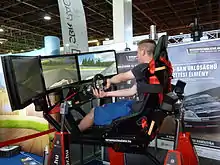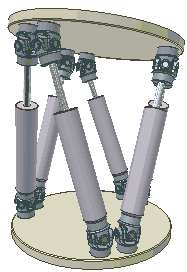Full motion racing simulator
A full motion racing simulator is a motion simulator that is purposed for racing, and must provide motion simulation in all six degrees of freedom, as defined by the aviation simulator industry many decades ago. The six degrees of freedom coincide with Earth physics, and are commonly referred to (in both aircraft, watercraft and other vehicles) as:
- The three translational movements: Surge, sway and heave (front/back motion, side-to-side motion and up/down motion, respectively)
- The three rotational movements: Roll, pitch, and yaw (rotation around the normal, transverse and longitudinal axes, respectively)

Simulations of these six degrees of freedom are usually achieved by tilting of a motion base (also called Stewart platform) which also changes the drivers position relative to the Earth's gravity, giving the sensation of acceleration.
In addition to the six degrees of freedom, it is also common to have force feedback in full motion racing simulators, most commonly in the steering wheel, but sometimes even in other controls as well. To create an even more immersive experience, full motion racing simulators are sometimes also combined with virtual reality headsets.
Definitions
To merely be called a motion racing simulator, the device in contrast only needs to have a motion simulation mechanism in at least 1 degree of freedom. However, any motion simulator with less than six degrees of freedom should not be referred to as full motion simulators.
It should also be noted that the term "simulator" in this article does not refer to the simulation software or game, but rather the physical hardware device that the driver sits in.
DOF comparison
The number of DOFs determine what kind of car and racing type can be simulated. 2DOF or 3DOF simulators can be sufficient if simulation of yaw, under and oversteer is not important. Advantages of some 2DOF setup can be lower price, quick response times and high speed.[1] 6DOF simulators can achieve yaw (turning), under and oversteer.
Different types of simulators may be more suitable for different use cases. Examples of other use cases may include simulating a motorbike, skiing og horseriding.
Arguably the two most common use cases are auto racing and flight simulators.
- Car racing simulators require quick movements, and it is often acceptable to have a short range. A 2DOF seat mover is one example of a common setup.
- Flight simulation requires wide angulations. Suitable setups may include 6 DOF models.[2]
Some common motion simulator setup types include:[2]
- 2DOF seat mover
- 2DOF with wheel and pedals on a gimball[3]
- 2DOF with wheel and pedals "joyrider"[4]
- 2DOF flatbed
- 3DOF with heave[5]
- 3DOF with traction loss[6]
- 3DOF with 360 degree rotation[7]
- 6 DOF[8]
DC motor actuators are usually more affordable, while AC motor setups generally are more powerful and expensive.[2]
Compatibility
Not all games support full motion simulation. Features and compatibilities may also vary with different hardware and software setups.
Layout
Full motion racing simulators are usually manufactured from steel or aluminum with mounting mechanisms for car controls, such as:
- A steering wheel
- Pedals (usually a throttle, a brake and a clutch pedal)
- Shifter (usually a H-Pattern, a floor mounted sequential and/or a paddle shifter)
- Seat
Ergonomics may also attempt to replicate the vehicle being simulated.
Different implementations of 6DOF
In motion simulation simulators, the cockpit or the occupant's seat is moved in coordination with a graphical output. Different examples of racing simulators with motion exist, some of which provide motion only to the driver's seat, and others that move the entire simulator cockpit including all car controls. Further differentiation exists regarding visual display technology and whether the simulators graphical output moves with, and stays relative to the sim, or is static and motionless.
The SimCraft APEX6 GTS [9] and Cruden [10] are examples of full motion racing simulators implemented in different ways, but both offer motion simulation on all 6 of the degrees of freedom. The Cruden system utilizes a Stewart Platform while SimCraft utilizes a proprietary "Physics based" approach with independent degrees of freedom.
Gallery
See also
- Driving simulator
- Virtual reality simulator
- Sim racing, collective term for auto racing games which aim to be realistic, but do not necessarily include motion simulation output
- Flight simulator
- Simulator ride
References
- How to choose a motion platform - Motion Systems
- FAQ #214: What kind of simulator for me?
- 2DOF Motion Simulator with truck wiper motor playseat
- The Laymens Guide To Virtual Reality Motion Flight Simulators - Ken Hill
- Motion Platform 3DoF - 750 kg (PS-3TM-750) - YouTube
- Asseto Corsa + Oculus Rift DK2 + 3DOF Motion Simulator = Reality ! - YouTube
- 3DOF 360 degree racing motion simulator on YouTube
- CKAS Electric 6DOF Motion Platforms / Systems
- https://www.simcraft.com/full-motion-racing-simulator-race-engineering/
- https://www.cruden.com/motorsport-driving-simulators/
